
Families who enjoy breakfast cereals like Cheerios, Lucky Charms, or Trix should feel the pinch by mid-January 2022 as General Mills announced a 20 percent price increase for over a hundred of its products.
According to CNN, General Mills attributed the breakfast cereal price increase to one of its "major regional wholesale suppliers." The report, however, did not elaborate on the changes and kept the supplier's identity anonymous to protect its business relationship with the food manufacturer.
Aside from the breakfast cereal, household brands like Pillsbury and Betty Crocker are also expected to become more expensive at the start of 2022. Though the 20 percent increase might be high, General Mills is not the only food company hiking up its prices as Kraft Heinz, the producer of Mac & Cheese, will also start selling its family-favorite product with a 20 percent price increase.
SNAP Benefits Affected by Price Increase
In October, people who depended on the government's food stamps SNAP benefits or the Supplemental Nutrition Assistance Program were relieved to receive a historic, monthly boost of 25 percent. The increase coincided with most states' expiration of the Emergency Coronavirus Relief Act. However, despite the SNAP benefits' enhancement, prices of grocery items have been soaring as well.
Diane Whitmore Schanzenbach of the Northwestern University's Institute for Policy Research told NBC News that low-income workers who need to feed a family continue to be affected by the price inflation since they still do not earn enough money to keep up with the rising prices. Food Resource and Action Center director Ellen Vollinger said that food banks continue to have high demand from people, especially from communities of color, who get a significant portion of their food budget from SNAP.
Though SNAP benefits are adjusted every year based on the inflation rates, it still does not reflect the reality of the struggles beneficiaries face. This is because prices have been changing and rising within a short period of time, and the annual adjustments have become outdated.
"The question is really what's going to happen in the interim between now and the next annual inflation adjustment," Lauren Bauer, an economist at the Brookings Institution, told NBC News. What's happening now in core goods is what's driving inflation, but it's also affecting food in unusual ways."
Nothing Has Changed Post-Pandemic
A survey among 20 million adults from September to October 2021 showed that 12 percent of families with kids still lack food supplies week after week despite the stimulus and other benefits from the government. As prices increased by 4.8 percent in October, many parents claimed they could not afford to pay for goods compared to a year ago.
Inflation is not the only factor impacting prices, as supply chain shortages, which started during the pandemic, have triggered more challenges for the food industry. Sourcing food has become a problem for manufacturers and food banks who rely on donations and pledges.
Though many believe that the problem of food insecurity is "solvable," a wave of resources and community engagement is necessary for those who rely on food benefits to thrive.